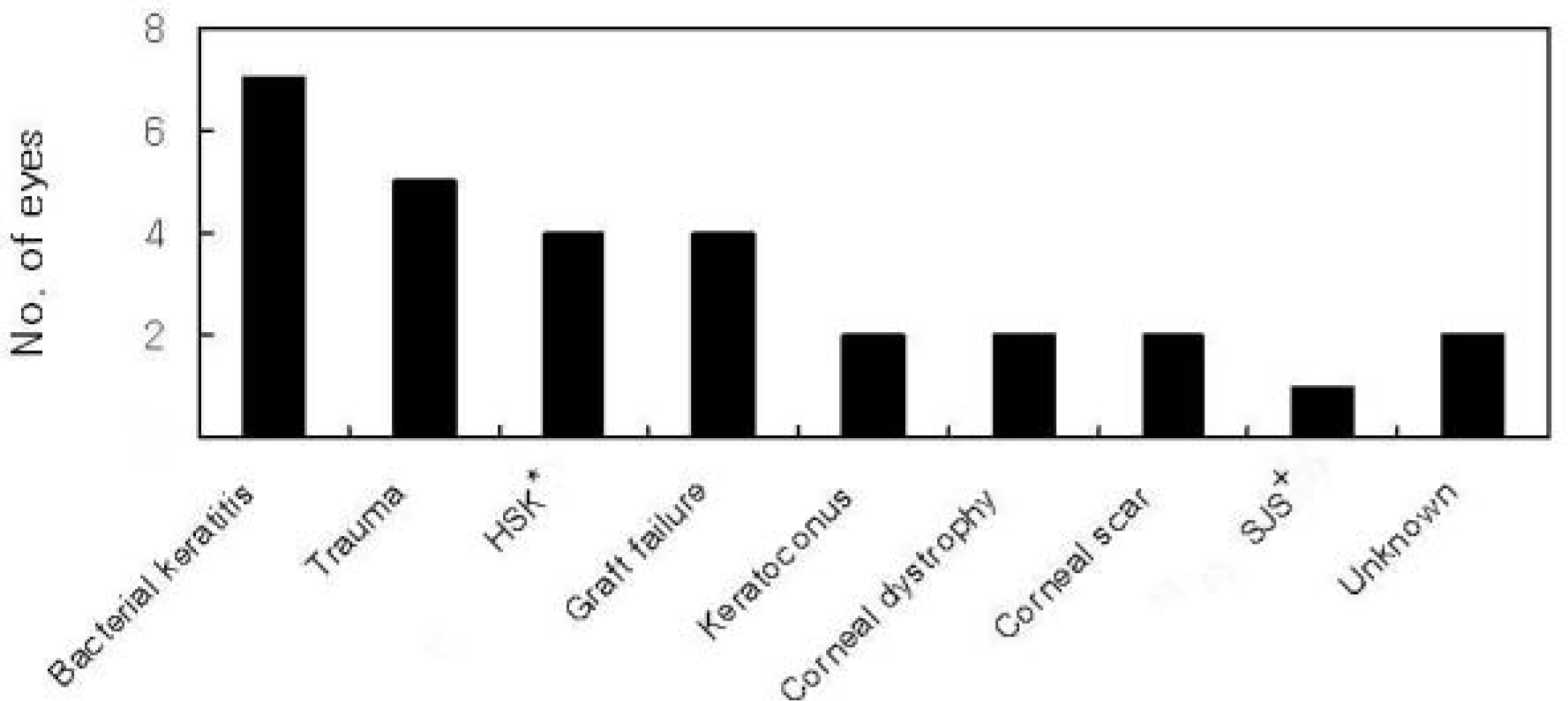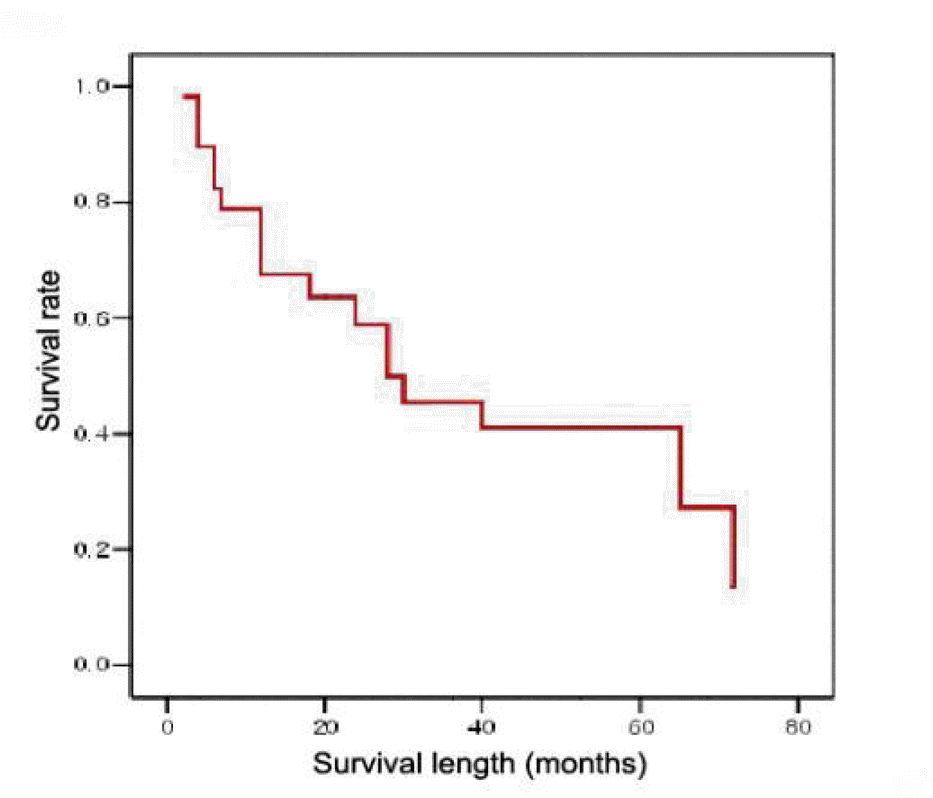Abstract
Purpose
To evaluate the clinical results of corneal triple procedure, as well as the causes and the risk factors for graft failure.
Methods
Indications, survival period of graft, causes of graft failure, and risk factors for failure in 29
patients (29 eyes) who had undergone penetrating keratoplasty combined with cataract surgery and intraocular lens (IOL) implantation were retrospectively analyzed.
Results
The most common primary indication of corneal triple procedure was bacterial keratitis (24%), followed by corneal trauma, herpes simplex keratitis, and graft failure. The average survival period of corneal graft in corneal triple procedure was 29.2±23.2 months. The most common cause of graft failure was allograft rejection (56.3%). The risk factors of graft failure by an univariate analysis were preoperative unfavorable diagnosis (bullous keratopathy, corneal ulcer, and trauma), corneal neovasculization, intraoperative additional procedure (anterior vitrectomy, synechiolysis, and anterior chamber irrigation), immune rejection, and postoperative glaucoma, but were unrelated to methods of cataract surgery, graft size, or IOL position.
In a multivariate analysis, graft rejection and corneal neovascularization were identified as risk factors for graft failure in patients undergoing triple procedure.
Go to : 
References
1. Davis EA, Stark WJ. The triple procedure-is it the best approach for the patient? The triple procedure may be superior to sequential surgery. Arch Ophthalmol. 2000; 118:414–5.

3. Kim SM, Sae WJ, Kim JH. Combined keratoplasty and cataract surgery. J Korean Ophthalmol Soc. 1995; 36:1669–76.
4. Cho EH, Tchah HW. Clinical result of penetrating keratoplasty combined with intraocular lens implantation or exchange. J Korean Ophthalmol Soc. 1996; 37:2031–40.
5. Bersudsky V, Rehany U, Rumelt S. Risk factors for failure of simultaneous penetrating keratoplasty and cataract extraction. J Cataract Refract Surg. 2004; 30:1940–7.

6. Hamil MB. The triple procedure-is it the best approach for the patient? Sequential surgery may be the best approach for the patients (controversies). Arch Ophthalmol. 2000; 118:415–7.
7. Sanford DK, Klesges LM, Wood TO. Simultaneous penetrating keratoplasty, extra -capsular cataract extraction, and intraocular lens implantation. J Cataract Refract Surg. 1991; 17:824–9.
8. Weisbrod DJ, Sit M, Naor J, Slomovic AR. Outcomes of repeat penetrating keratoplasty and repeat penetrating keratoplasty and risk factors for graft failure. Cornea. 2003; 22:429–34.
10. Yoon KC, Park YK, Park YG. Surgical results of repeat penetrating keratoplasty and risk factors for graft failure. J Korean Ophthalmol Soc. 2004; 45:1827–32.
11. Kim SM, Sae WJ, Kim JH. Combined keratoplasty and cataract surgery. J Korean Ophthalmol Soc. 1995; 36:1669–76.
12. Sridhar MS, Murthy S, Bansal AK, Rao GN. Corneal triple procedure: indications, complications, and outcomes. Cornea. 2000; 19:333–5.

13. Katzin HM, Meltzer JF. Combined surgery for corneal transplantation and cataract extraction. Am J Ophthalmol. 1996; 556–60.

15. Heidemann DG, Dunn SP. Visual results and complications of transsclerally sutured intraocular lenses in penetrating keratoplasty. Ophthalmic Surg. 1990; 21:609–14.

16. Heidemann DG, Dunn SP. Transsclerally sutured intraocular lenses in penetrating keratoplasty. Am J Ophthalmol. 1992; 113:619–25.

17. Yamaguchi S, Suzuki Y, Tsuru T. Risk factors for graft failure in penetrating keratoplasty. Acta Ophthalmol Scand. 1996; 74:584–8.
18. Lomholt JA, Ehlers N. Graft survival and risk factors of penetrating keratoplasty for microbial keratitis. Acta Ophthalmol Scand. 1997; 75:418–22.

19. Inoue K, Amaos S, Oshika T, Tsuru T. Risk factors for corneal graft and rejection in penetrating keratoplasty. Acta Ophthalmol Scand. 2001; 79:251–5.
20. Jonas JB, Rank RM, Budde WM, Sauder G. Factors influencing visual outcome after penetrating keratoplasty combined with intraocular lens implantation. Eur J Ophthalmol. 2003; 13:134–8.

21. Williams KA, Esterman AJ, Bartlett C, et al. How effective is penetrating corneal transplantation? Factors influencing long-term outcome in multivariate analysis. Transplantation. 2006; 81:896–901.

22. Maquire MG, Stark WJ, Gottsch JD, et al. Risk factors for corneal graft failure and rejection in the collaborative corneal transplantation studies. Collaborative Corneal Transplantation Studies Research Group. Ophthalmology. 1994; 101:1536–47.
Go to : 
 | Figure 1.The distribution of preoperative diagnosis in corneal triple procedure. † SJS : Stevens-Johnson syndrome. |
 | Figure 2.Kaplan-Meier cumulative survival proportional curve of corneal grafts in corneal triple procedure. † SJS : Stevens-Johnson syndrome. |
Table 1.
Causes of graft failure in corneal triple procedure
| Causes | No. of patients (%) |
|---|---|
| Allograft rejection | 9 (56.3) |
| Bullous keratopathy | 3 (18.8) |
| Postoperative glaucoma | 2 (12.5) |
| Endothelial failure | 1 (6.2) |
| Recurrence of host disease | 1 (6.2) |
| Total | 16 (100) |
Table 2.
Univariate analysis of risk factors for graft failure in corneal triple procedure
| Factors | No. of patients (%) | P-value | |
|---|---|---|---|
| Graft success | Graft failure | ||
| Preoperative diagnosis | |||
| Favorable* | 7 (53.8) | 3 (18.8) | 0.02 |
| Unfavorable† | 6 (46.2) | 13 (81.2) | |
| Corneal neovasculization | |||
| Presence | 4 (30.8) | 10 (62.5) | <0.01 |
| Absence | 9 (69.2) | 6 (37.5) | |
| Methods of cataract surgery | |||
| Planned ECCE‡ | 9 (69.2) | 8 (50.0) | |
| Phacoemulsification | 3 (23.1) | 2 (12.5) | 0.15 |
| ICCE§ | 1 (7.7) | 6 (37.5) | |
| Intraoperative additional intervention | |||
| Presence | 5 (46.2) | 11 (68.7) | 0.04 |
| Absence | 8 (53.8) | 5 (31.3) | |
| Donor size | |||
| < 7.5 mm | 1 (0.09%) | 2 (11.1%) | |
| ≥ 7.5 mm, < 8.0 mm | 8 (72.7%) | 6 (33.3%) | 0.10 |
| ≥ 8.0 mm | 2 (0.18%) | 10 (55.5%) | |
| Immune rejection | |||
| Presence | 3 (23.1) | 13 (81.3) | 0.03 |
| Absence | 10 (76.9) | 3 (18.7) | |
| Postoperative glaucoma | |||
| Presence | 3 (23.1) | 9 (56.3) | 0.04 |
| Absence | 10 (76.9) | 7 (43.7) | |
| IOLπ position | |||
| In the bag | 9 (69.2) | 10 (62.5) | 0.71 |
| Sulcus or scleral fixation | 4 (30.8) | 6 (37.5) | |
Table 3.
Multivariate analysis of risk factors for graft failure in corneal triple procedure
| Risk factor | P-value | Relative risk | 95% CI* | |
|---|---|---|---|---|
| Lower | Upper | |||
| Unfavorable diagnosis | 0.12 | 1.99 | 2.28 | 5.09 |
| Immune rejection | 0.03 | 4.51 | 1.11 | 13.11 |
| Postoperative glaucoma | 0.50 | 0.46 | 0.48 | 4.45 |
| Preoperative corneal neovasculization | 0.02 | 5.32 | 1.28 | 16.17 |
| Graft size ≥ 8.0mm | 0.40 | 0.72 | 0.81 | 4.82 |
| Intraoperative additional intervention | 0.34 | 0.90 | 0.13 | 2.05 |
| Sulcus or scleral fixation of IOL† | 0.29 | 0.88 | 0.61 | 4.80 |




 PDF
PDF ePub
ePub Citation
Citation Print
Print


 XML Download
XML Download